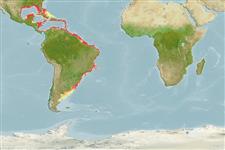Environment: milieu / climate zone / depth range / distribution range
Écologie
marin; eau douce; saumâtre démersal; catadrome (Ref. 46888); profondeur 10 - ? m (Ref. 3791). Subtropical; 32°N - 51°S
Western Atlantic: Bermuda, Florida (USA), Bahamas, and throughout the Caribbean Sea to Argentina.
Length at first maturity / Taille / Poids / Âge
Maturity: Lm 35.0, range 40 - ? cm
Max length : 80.0 cm TL mâle / non sexé; (Ref. 5217); 69.0 cm TL (female); common length : 40.0 cm TL mâle / non sexé; (Ref. 5217); poids max. publié: 9.0 kg (Ref. 5217)
Épines dorsales (Total) : 5; Rayons mous dorsaux (Total) : 8; Épines anales: 3; Rayons mous anaux: 8.
Inhabit coastal marine waters and brackish estuaries (Ref. 3791); also found in hyper-saline lagoons and may enter freshwater (Ref. 5217). Never far from the sea (Ref. 3791). Form sizeable schools (Ref. 3791). Appear to undergo trophic migrations along the coasts (Ref. 35237). Feed on organic detritus and filamentous algae (Ref. 9626). Oviparous, eggs are pelagic and non-adhesive (Ref. 205). Spawn several million eggs (Ref. 35237) at sea (Ref. 3791). Also caught with beach nets (Ref. 5217). Marketed fresh and salted (Ref. 5217). The roe is marketed salt-pickled and dried and considered a delicacy (Ref. 5217).
Life cycle and mating behavior
Maturities | Reproduction | Spawnings | Egg(s) | Fecundities | Larves
Robins, C.R. and G.C. Ray, 1986. A field guide to Atlantic coast fishes of North America. Houghton Mifflin Company, Boston, U.S.A. 354 p. (Ref. 7251)
Statut dans la liste rouge de l'IUCN (Ref. 130435)
Menace pour l'homme
Harmless
Utilisations par l'homme
Pêcheries: commercial; Aquaculture: commercial
Outils
Articles particuliers
Télécharger en XML
Sources Internet
Estimates based on models
Preferred temperature (Ref.
123201): 22.5 - 27.7, mean 25.5 °C (based on 280 cells).
Phylogenetic diversity index (Ref.
82804): PD
50 = 0.5000 [Uniqueness, from 0.5 = low to 2.0 = high].
Bayesian length-weight: a=0.01047 (0.00905 - 0.01211), b=2.95 (2.92 - 2.98), in cm total length, based on LWR estimates for this species (Ref.
93245).
Niveau trophique (Ref.
69278): 2.0 ±0.00 se; based on food items.
Résilience (Ref.
120179): Milieu, temps minimum de doublement de population : 1,4 à 4,4 années (K=0.11-0.24; assuming tm=2-3).
Prior r = 0.33, 95% CL = 0.22 - 0.50, Based on 7 data-limited stock assessments.
Fishing Vulnerability (Ref.
59153): Moderate vulnerability (37 of 100).
Climate Vulnerability (Ref.
125649): High vulnerability (57 of 100).
Nutrients (Ref.
124155): Calcium = 152 [57, 453] mg/100g; Iron = 2.51 [0.46, 11.24] mg/100g; Protein = 19.8 [18.3, 21.2] %; Omega3 = 0.464 [0.221, 1.025] g/100g; Selenium = 60.8 [21.7, 208.2] μg/100g; VitaminA = 6.03 [1.72, 21.87] μg/100g; Zinc = 1.73 [0.83, 4.23] mg/100g (wet weight); based on
nutrient studies.
